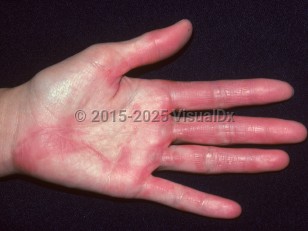Potentially life-threatening emergency
Toxic shock syndrome in Infant/Neonate
Alerts and Notices
Important News & Links
Synopsis

Toxic shock syndrome (TSS) is a severe exotoxin-mediated bacterial infection that is characterized by the acute onset of high fever, headache, conjunctival injection, erythema of the pharynx, vomiting, diarrhea, and hypotension. Two subtypes of TSS exist, based on the bacterial etiology: Staphylococcus aureus and group A streptococci. Significantly, the severity of TSS can range from mild disease to rapid progression to shock and end organ failure.
Children are most susceptible to TSS between the ages of 6 months and 2 years. Before 6 months, the birthing parent's antibodies are protective, and after age 2 years, the child begins producing antibody titers in higher amounts. TSS mortality rates are much lower in children than adults, at 5%-10% and 3%-5% for streptococcal versus staphylococcal types, respectively.
Note: An increase in invasive S pyogenes (invasive group A streptococcal [iGAS]) infections in children, including necrotizing fasciitis and streptococcal TSS, has been reported in Europe and the United States in 2022-2023.
TSS may result from surgical wounds, burns, or any other type of mucous membrane, skin, or soft tissue infection with S aureus. If the US Centers for Disease Control (CDC) criteria are strictly followed, TSS is extremely rare in infants (refer to Diagnostic Pearls section for CDC definition of staphylococcal TSS). Partial expression may be due to passive immunity conferred by maternal antibodies during the first 3-6 months of life, the increased tolerance of infantile T cells to superantigens, and early treatment leading to a blunted course. Names for these partial expressions of toxin-mediated disease include neonatal toxic shock syndrome-like exanthematous disease (NTED) and staphylococcal toxemia.
Children are most susceptible to TSS between the ages of 6 months and 2 years. Before 6 months, the birthing parent's antibodies are protective, and after age 2 years, the child begins producing antibody titers in higher amounts. TSS mortality rates are much lower in children than adults, at 5%-10% and 3%-5% for streptococcal versus staphylococcal types, respectively.
Note: An increase in invasive S pyogenes (invasive group A streptococcal [iGAS]) infections in children, including necrotizing fasciitis and streptococcal TSS, has been reported in Europe and the United States in 2022-2023.
TSS may result from surgical wounds, burns, or any other type of mucous membrane, skin, or soft tissue infection with S aureus. If the US Centers for Disease Control (CDC) criteria are strictly followed, TSS is extremely rare in infants (refer to Diagnostic Pearls section for CDC definition of staphylococcal TSS). Partial expression may be due to passive immunity conferred by maternal antibodies during the first 3-6 months of life, the increased tolerance of infantile T cells to superantigens, and early treatment leading to a blunted course. Names for these partial expressions of toxin-mediated disease include neonatal toxic shock syndrome-like exanthematous disease (NTED) and staphylococcal toxemia.
Codes
ICD10CM:
A48.3 – Toxic shock syndrome
SNOMEDCT:
18504008 – Toxic shock syndrome
A48.3 – Toxic shock syndrome
SNOMEDCT:
18504008 – Toxic shock syndrome
Look For
Subscription Required
Diagnostic Pearls
Subscription Required
Differential Diagnosis & Pitfalls

To perform a comparison, select diagnoses from the classic differential
Subscription Required
Best Tests
Subscription Required
Management Pearls
Subscription Required
Therapy
Subscription Required
References
Subscription Required
Last Reviewed:02/26/2022
Last Updated:05/11/2025
Last Updated:05/11/2025
Potentially life-threatening emergency
Toxic shock syndrome in Infant/Neonate

